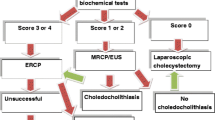Abstract
Background
Detection of common bile duct (CBD) stones in patients with acute biliary pancreatitis (ABP) proves challenging. We hypothesized that grouping clinically significant predictors would increase reliability of detection.
Methods
A retrospective review was performed of 144 consecutive patients who presented to a single tertiary care institution from 2002 to 2007 with ABP.
Results
Of the 144 patients, 32 had a persistent CBD stone. Following multivariate analysis, admission CBD size on ultrasound, gamma glutamyl transferase (GGT), alkaline phosphatase (AP), total bilirubin (TB), and direct bilirubin (DB) significantly correlated with persistent CBD stone. Receiver operator curve analysis and linear regression were applied to obtain optimal and equitable predictive values, and variables combined. Optimal values were: CBD ≥ 9 mm; AP ≥ 250 U/l; GGT ≥ 350 U/l; TB ≥ 3 mg/dl; and DB ≥ 2 mg/dl. Presence of five variables had an associated odds ratio (OR) of 53.1 (p < 0.001) and four variables an OR of 8.97 (p = 0.004) for presence of persistent CBD stone. Zero variables conferred a significantly decreased probability of CBD stone, OR 0.15 (p < 0.001). Presence of one to three variables did not predict presence of CBD stone.
Conclusion
Presence of four or five variables significantly correlated with persistent CBD stone. Biliary evaluation by endoscopic retrograde cholangiopancreatography is suggested, as initial magnetic resonance cholangiopancreatography (MRCP) may only increase cost and delay time to intervention. In the absence of any variable, biliary evaluation by intraoperative cholangiogram may be sufficient. Decisions regarding patients with one to three variables should occur on a case-to-case basis. Initial biliary evaluation by MRCP is likely preferable, however, as no increased probability of CBD stone was identified, thus not warranting risks associated with intervention.

Similar content being viewed by others
References
Riela A, Zinsmeister AR, Melton LJ, DiMagno EP. Etiology, incidence, and survival of acute pancreatitis in Olmsted County, Minnesota. Gastroenterology 1991;100:A296.
Frossard JL, Steer ML, Pastor CM. Acute pancreatitis. Lancet 2008;371(9607):143–152.
Wilson C, Imrie CW, Carter DC. Fatal acute pancreatitis. Gut 1988;29(6):782–788.
Corfield AP, Cooper MJ, Williamson RC. Acute pancreatitis: a lethal disease of increasing incidence. Gut 1985;26(7):724–729.
Wilson C, Imrie CW, Carter DC. Fatal acute pancreatitis. Gut 1988;29(6):782–788.
Acosta JM, Rubio Galli OM, Rossi R, Chinellato AV, Pellegrini CA. Effect of duration of ampullary biliary obstruction on severity of lesions of acute pancreatitis. J Am Coll Surg 1997;184(5):499–505.
Chang L, Lo SK, Stabile BE, Lewis RJ, de Virgilio C. Biliary pancreatitis: a prospective study on the incidence of cholangitis and clinical predictors of retained common bile duct stones. Am J Gastroenterol 1998;93(4):527–531.
Cohen ME, Slezak L, Wells CK, Andersen DK, Topazian M. Prediction of bile duct stones and complications in biliary pancreatitis using early laboratory trends. Am J Gastroenterol 2001;96(12):3305–3311.
Roston AD, Jacobson IM. Evaluation of the pattern of liver tests and yield of cholangiography in symptomatic choledocholithiasis: a prospective study. Gastrointest Endosc 1997;45(5):394–399.
Moretti A, Papi C, Aratari A, Festa V, Tanga M, Koch M, et al. Is early endoscopic retrograde cholangiopancreatography useful in the management of acute biliary pancreatitis? A meta-analysis of randomized controlled trials. Dig Liver Dis 2008;40(5):379–385.
Petrov MS, van Santvoort HC, Besselink MG, van der Heijden GJ, van Erpecum KJ, Gooszen HG. Early endoscopic retrograde cholangiopancreatography versus conservative management in acute biliary pancreatitis without cholangitis: a meta-analysis of randomized trials. Ann Surg 2008;247(2):250–257.
Diagnosis and treatment of common bile duct stones (CBDS). Results of a consensus development conference. Scientific Committee of the European Association for Endoscopic Surgery (E.A.E.S.). Surg Endosc 1998;12(6):856–864.
Vitale GC. Early management of acute biliary pancreatitis. Ann Surg 2007;245(1):18–19.
Folsch UR, Nitsche R, Lüdtke R, Hilgers RA, Creutzfeld W. Early ERCP and papillotomy compared with conservative treatment for acute biliary pancreatitis. N Engl J Med 1997;336:237–242.
de Virgilio C, Verbin C, Chang L, Linder S, Stabile BE, Klein S. Biliary pancreatitis. The role of preoperative endoscopic retrograde cholangiopancreatography. Arch Surg 1994;129(9):90912.
Acosta JM, Katkhouda N, Debian KA, Groshen SG, Tsao-Wei DD, Berne TV. Early ductal decompression versus conservative management for biliary pancreatitis with ampullary obstruction: a prospective randomized clinical trial. Ann Surg 2006;243(1):33–40.
Chan T, Yaghoubian A, Rosing D, Lee E, Lewis RJ, Stabile BE, De Virgilio C. Total bilirubin is a useful predictor of persisting common bile duct stone in gallstone pancreatitis. Am Surg 2008;74(10):977–980.
Lin G, Halevy A, Girtler O, Gold-Deutch R, Zisman A, Scapa E. The role of endoscopic retrograde cholangiopancreatography in management of patients recovering from acute biliary pancreatitis in the laparoscopic era. Surg Endosc 1997;11(4):371–375.
Chak A, Hawes R, Cooper GS, et al. Prospective assessment of the utility of EUS in the evaluation of gallstone pancreatitis. Gastrointest Endosc 1999;49:599–604.
Liu CL, Fan ST, Lo CM, et al. Comparison of early endoscopic ultrasonography and endoscopic retrograde cholangiopancreatography in the management of acute biliary pancreatitis: a prospective randomized study. Clin Gastroenterol Hepatol 2005;3:1238–1244.
Moon JH, Cho YD, Cha SW, et al. The detection of bile duct stones in suspected biliary pancreatitis: comparison of MRCP, ERCP, and intraductal US. Am J Gastroenterol 2005;100:1051–1057.
Varghese JC, Liddell RP, Farrell MA, Murray FE, Osborne H, Lee MJ. The diagnostic accuracy of magnetic resonance cholangiopancreatography and ultrasound compared with direct cholangiography in the detection of choledocholithiasis. Clin Radiol 2000;55(7):579.
Mofidi R, Lee AC, Madhavan KK, Garden OJ, Parks RW. The selective use of magnetic resonance cholangiopancreatography in the imaging of the axial biliary tree in patients with acute biliary pancreatitis. Pancreatology 2008;8(1):55–60.
Author information
Authors and Affiliations
Corresponding author
Rights and permissions
About this article
Cite this article
Telem, D.A., Bowman, K., Hwang, J. et al. Selective Management of Patients with Acute Biliary Pancreatitis. J Gastrointest Surg 13, 2183–2188 (2009). https://doi.org/10.1007/s11605-009-1041-1
Received:
Accepted:
Published:
Issue Date:
DOI: https://doi.org/10.1007/s11605-009-1041-1




